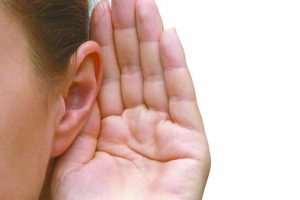October 1, 2025
Ask the Audiologist
How Can I Protect My Hearing from Loud Noises?

By Alexandra Wright, Au.D.
Audiology Consultants, P.C.
Noise-induced hearing loss is estimated to affect about 24% of adults in the United States, which makes the question of how to protect your hearing from excessive noise damage a very important one. The goal when obtaining adequate hearing protection is all about the amount of noise the devices are able to reduce and how well the device fits. There are several different factors that go into choosing the device that is best for your needs.
Noise Reduction Ratings (NRR): When searching for a proper hearing protection device the first thing to look for is the NRR. This is a standardized rating system that determines how many decibels the hearing protection devices are able to reduce when worn properly. The higher the NRR, the more protection provided by the devices. An NRR between 20–30 is going to be most appropriate for the average person’s needs (e.g., mowing the lawn, working with power tools or yard equipment, fireworks) while someone who participates in game or recreational hunting or shooting should aim for an NRR closer to 30 or above. If you are an avid concert goer, the ideal NRR would be better around 13–18 to allow for protection from damaging noise while keeping the concert clear.
 Styles of Hearing Protection: There are several different styles of hearing protection devices available to consumers, and each style can meet different protection needs. Some forms can be easier to keep on your person for quick access when noise levels rise to hazardous levels.
Styles of Hearing Protection: There are several different styles of hearing protection devices available to consumers, and each style can meet different protection needs. Some forms can be easier to keep on your person for quick access when noise levels rise to hazardous levels.
Muffs: One of the most popular styles of hearing protection is over-the-ear muffs. This style is great for someone who will be taking the hearing protection on and off throughout their activity and allows for quick removal and placement. It is also the style that is the easiest to wear correctly. When choosing a muff-style hearing protection device, always make sure the muff fully covers the entire outer ear with no gaps to ensure maximum noise reduction.
Foam Plugs: Foam plugs are easily the most accessible form of hearing protection available; however, they are also the most common form of hearing protection to be worn incorrectly. When wearing a foam plug, for best insertion, roll the plug between two fingers until it is nearly flat, then insert fully into the ear canal while pulling up and back on the outer ear to straighten out the ear canal. Once fully inserted, hold in place with one finger until the plug fully expands to fill the entire ear canal space. When placed properly, foam plugs can provide adequate hearing protection in most cases, but the amount of noise that can be reduced will decrease with each reuse.
Christmas Tree Plugs: Another form of hearing protection that goes into the ear looks like tiny Christmas trees on a post. This style will typically provide the least amount of noise reduction due to its shape and material. This style can often be found to be made for musicians or music earplugs because it helps to maintain the fidelity of sound to keep music sounding more natural. Similar to the foam plugs, it is important to pull up and back on the earlobe when inserting to get the plug to the appropriate depth to provide the best protection from noise.
Custom Ear Plugs: For individuals that frequently find themselves around hazardous noise, custom earplugs are often recommended to ensure the best protection. To have custom hearing protection made, you can visit an audiologist to have an impression taken of each ear before sending it off to a manufacturer to be molded specifically for your ear. The benefits of this style allow for a proper seal every time because the devices are molded to the exact ear shape of the wearer. Custom hearing protection can be especially helpful for people who have to take their plugs in and out frequently or find traditional hearing protection uncomfortable. Many musicians have filtered versions of this style made to keep them comfortable and hearing clearly.
Keeping your noise protection devices easily accessible is a great way to protect your hearing and ensure consistent use. It is always best to wear hearing protection whenever surrounded by hazardous noise in your environments (e.g., loud concerts/music, mowing the lawn/yard equipment, power tools, factory equipment, hunting/shooting, fireworks, motorcycles). Consistent use can greatly help to decrease the risk of noise-induced hearing loss and hearing loss side effects such as tinnitus (ringing in the ears). If you are ever unsure what hearing protection is best for you and your hearing needs, contact your local audiologist, and they will be happy to assist you in making the right choice for you!
Alexandra Wright is an audiologist at Audiology Consultants, P.C. For more information, visit audiologyconsultants.com. Stores are located in Davenport, IA, Muscatine, IA, Moline, IL, and Geneseo, IL.
Filed Under: Community, Family, Health & Wellness, News, Technology
Trackback URL: https://www.50pluslife.com/2025/10/01/ask-the-audiologist-157/trackback/


